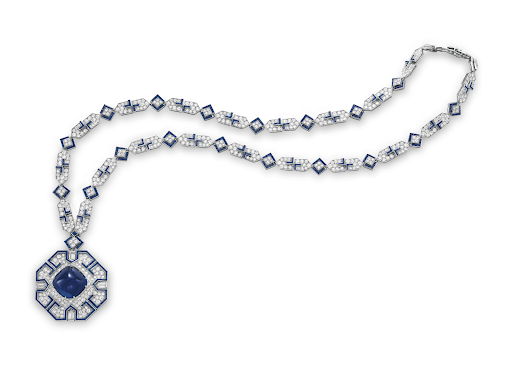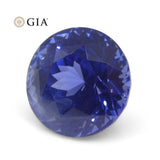
Famous Sapphire Jewellery, Part 1: Notorious Necklaces
Share
Throughout recorded history, sapphires have captivated humans from across the globe. These entrancing gems have often been associated with wisdom, nobility, and a calm temperament, making them a favourite of the wealthy and powerful. Sapphires have accompanied their owners as components of immaculate jewellery pieces that embody the regal character of both stones they hold, and the person wearing them. Some of the world’s most notable pieces of sapphire jewellery are scintillating neckwear.
A piece of sapphire jewellery that deserves attention is the Hill sapphire pendant. This eloquent gold pendant features a 22.66 carat cushion shaped Kashmir sapphire as its centre stone, surrounded with brilliant cut diamonds. The sapphire bears the name of railroad magnate James J. Hill, who purchased the stone from Randel, Baremore & Billings. Hill was an avid art collector and bought the gem for $2,200 on December 24th, 1886 as part of a gift for his wife Mary T. Mehegan Hill. Hill had the sapphire fashioned into a pendant for Mary that began its existence as the centrepiece of an intricate sapphire and diamond encrusted necklace. The sapphire pendant was eventually given to one of Hill’s daughters, Gertrude Gavin, who then gave the pendant to her sister Rachel Boeckmann. After Boeckmann’s death, one of her daughters donated the jewel in 2006 to the James J. Hill House Historic Site in St. Paul, Minnesota. The jewel changed hands again on April 24th, 2007 when the pendant was purchased at an auction held by Christie’s New York for $3,064,000. This gem broke the record at the time for most expensive sapphire per carat, and is an important part of jewellery history.

An extravagant piece of jewellery, the Bismarck sapphire necklace is an extraordinary necklace which currently sits in the Smithsonian Institution. The necklace is named after its previous owner, Countess Mona von Bismarck, wife of Count Eduard von Bismarck. The necklace’s central sapphire was originally purchased in 1926 while the Countess was on honeymoon in Sri Lanka with her previous husband, Harrison Williams, and it had been first set horizontally in a Cartier necklace designed in 1927; the Countess married Count Bismarck in 1955, two years after Williams’ death, and had the sapphire reset vertically in its current mount four years later in 1959. A breathtaking gem, the Bismarck Sapphire originates from Burma (Myanmar) and weighs 98.57 carats. This incredible stone possesses perfect cornflower blue colour and nearly ideal clarity. In its current setting, the Bismarck Sapphire hangs on a necklace of baguette and round diamonds, surrounded with square shaped sapphire, baguette diamond, and round diamond accents. The Countess donated the Bismarck Sapphire necklace to the Smithsonian Institution in 1967, and it remains on display in the National Museum of Natural History as one of the significant sapphire treasures of the world.

A truly glorious piece of jewellery, the Hall Sapphire necklace is a grand display of sapphire’s radiance. Named after its previous owner, Evelyn Annenberg Hall, sister of philanthropist Walter Annenberg, the Hall necklace was donated to the Smithsonian Institution in 1979, where it is currently on display in the Gem Hall of the National Museum of Natural History. Originally crafted by Harry Winston, the Hall necklace features 36 matched cushion shaped Ceylon sapphires totalling 195 carats in weight, accented by 435 pear and round shaped diamonds totalling 83.75 carats in weight. The sapphires in the Hall necklace display a rich deep sky blue colour with high grade clarity. An absolutely brilliant jewel, the Hall sapphire necklace is a spectacular example of human craftsmanship and perfectly illustrates the splendour of sapphire necklaces.

One of the most recognizable pieces of bespoke sapphire jewellery in the world is the Bulgari sapphire sautoir that was owned by the late Elizabeth Taylor. The immaculate necklace was purchased for Taylor in 1972 by Richard Burton as a 40th birthday present. The chain of the necklace is constructed from pavé diamond links with calibré cut sapphire accents, and holds a pavé diamond and calibré sapphire pendant, featuring a stunning unheated 52.72 carat sugarloaf cabochon Burmese sapphire as its centre stone, which can be detached to wear as a brooch. Taylor was extremely fond of this jewel and was frequently seen wearing it; she even purchased the famous Bulgari Trombino sapphire ring to match her beloved sautoir. In 2011, many of Taylor’s jewels were sold as part of “The Collection of Elizabeth Taylor: The Legendary Jewels” auction held by Christie’s in New York. On December 12th, 2011 the sautoir sold for $5,906,000 to Bulgari, and is now one of many pieces in the Bulgari Heritage Collection. The public was reintroduced to the necklace two years later in 2013 when Jessica Chastain wore the sautoir and matching Trombino ring on the red carpet of the Cannes Film Festival, capturing the attention of onlookers from across the globe. One of the great sapphire jewels of this planet, Elizabeth Taylor’s Bulgari sapphire sautoir will go down in history as one of the most well known sapphire jewels of recent times.

The necklace which holds the Blue Belle of Asia is a sapphire necklace that has few equals if any. A massive prong set cushion shaped 392.52 carat unheated Ceylon sapphire, the Blue Belle of Asia is one of the largest faceted sapphires in the world. The stone was originally unearthed in the Ratnapura mining district of Sri Lanka in 1926, and was purchased in 1937 by British noble, Viscount Nuffield. The gem was brought back to England by Nuffield who eventually sold it. There are no records of who owned the sapphire after Nuffield, but the stone appeared again years later set into its current mount. The necklace features the Blue Belle as its centre stone, which is accented with a brilliant cut diamond tassel ending in oval diamond tips, suspended on a chain of brilliant cut diamonds. The reappearance of this marvellous jewel occurred in 2014 at the “Magnificent Jewels” auction held by Christie’s Geneva on November 10th of that year. The necklace sold for the equivalent of $17,305,996, making it one of the most expensive pieces of jewellery in history.

Glorious examples of sapphire jewellery, these necklaces are tasteful demonstrations of how sapphires can be used to make impactful pieces of wearable art. Learn about beautiful brooches that feature sapphires in the next instalment of this series.
We'd love to help you turn any of these gorgeous sapphires into a piece of custom jewellery:
© Yaĝé Enigmus









